Guest post originally published on the Signadot blog by Arjun Iyer and Scott Cotton
Introduction
Asynchronous architectures are common in cloud native applications as it decouples services and improves the scalability and reliability of the system. A message queue forms the basis of an asynchronous architecture and you can choose one from a myriad of options ranging from open source tools like Kafka and RabbitMQ to managed systems like Google Cloud Pub/Sub and AWS SQS. Among the various options available for a message queue, Apache Kafka is a popular choice in cloud native applications due to its high throughput and low latency capabilities. Kafka’s distributed architecture, fault-tolerance, and scalability make it an ideal choice for building highly resilient and responsive asynchronous architectures.
Testing Kafka-based asynchronous workflows
Since Kafka is a distributed system, setting up a test environment requires setting up multiple components such as brokers, producers and consumers. You would need to configure it correctly with considerations around security, replication, and partitioning. Moreover, setting up services that publish to and consume from Kafka can be time consuming, especially when dealing with different programming languages and frameworks. As a result, setting up an environment that includes Kafka to test end-to-end flows in an isolated manner poses unique challenges.
In this context, we define a Tenant as an actor that needs to run a test scenario in isolation.
Here are three approaches for testing end-to-end flows involving Kafka, each with its own set of advantages and trade-offs in terms of resource isolation and costs.
1. Isolate Kafka Cluster
If you want complete isolation between tenants, you can opt to create a new Kafka cluster for each tenant, including all the producers and consumers. However, this approach can be difficult to manage, especially if you have a resource-intensive Kafka cluster along with many services. Without automation to keep each environment up to date with changes merged to the main branch, these environments can quickly become outdated and require a significant amount of effort to maintain.
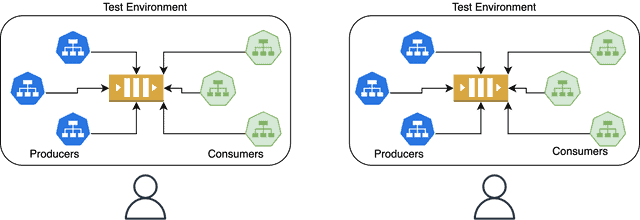
Advantages:
- High isolation between environments
Considerations:
- High expenses due to duplicating the entire infrastructure for each tenant
- Complex management overhead of multiple independent environments
- Requires automation to keep all services updated across each environment on an ongoing basis
2. Isolate Kafka Topics
Another option is to use a single Kafka cluster for all tenants and create new ephemeral topics as required for each tenant. You still need to spin up all producers and consumers and reconfigure them to connect to the newly provisioned topic(s) to test end-to-end flows. Although this option can save you costs compared to the previous approach, it may not be practical if you have a complex set of producers and consumers that use Kafka since you will need to duplicate and reconfigure these services for each new topic.
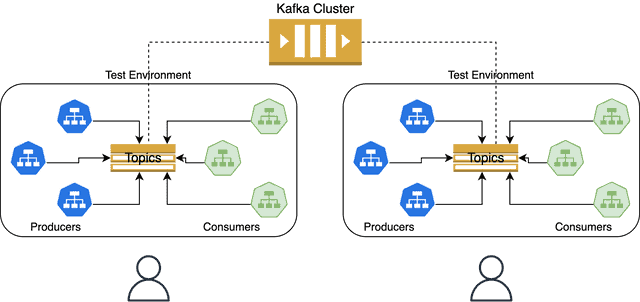
Advantages:
- Cost savings realized by sharing Kafka clusters across multiple environments
Considerations:
- The need to set up automation around setting up and tearing down Kafka topics for each test environment
- The need to duplicate all services for each environment, which can lead to operational complexity
- The need to reconfigure all services to connect to the newly created topics, which can be error-prone
3. Isolate Kafka Messages
In this approach, you establish a “baseline” environment that includes Kafka and all services, including producers and consumers. This baseline could be a pre-production environment that is continuously updated using a CI/CD tool of your choice. All tenants share this baseline. Each tenant has a mapping to a set of services “under-test”. To isolate tenants from each other, you leverage dynamic routing of requests and messages. You use OpenTelemetry to tag and propagate headers through services and Kafka. Requests and messages are then dynamically routed to specific services based on the value of these headers.
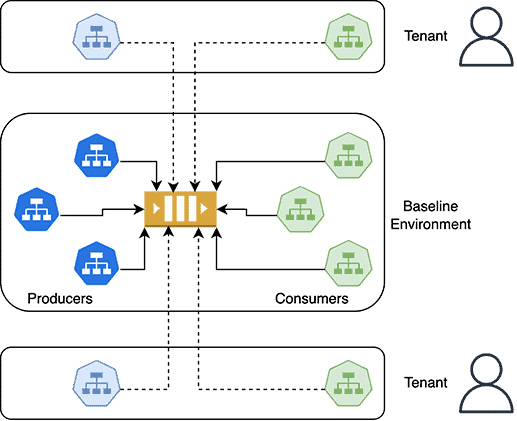
Advantages:
- No need to set up / tear down infrastructure for each test environment
- The most cost-efficient model, particularly when you have a complex Kafka setup and many services
- The lowest operational overhead since each environment only has a minimal number of services running
- Eliminates the problem of stale environments since the baseline is continuously updated based on an existing CI/CD pipeline
Considerations:
- Requires some effort to instrument your services using OpenTelemetry
- Kafka consumers need to be modified to selectively consume from Kafka
- May not be the best option if infrastructure level isolation is needed
The optimal approach to scale testing cost effectively for asynchronous flows is option 3 above. This is described in detail in the rest of this article.
Implementing Message Isolation based Testing
In this system, a tenant is assigned a unique tenantID with mappings to specific “under-test” versions of services that need to be tested together. Whenever a request or message is sent, it is tagged with the tenantID and dynamically routed to specific versions of services based on the mapping.
As the tenantID is used for routing decisions during synchronous and asynchronous inter-service communication, you need to propagate it across service calls. For synchronous calls, you can propagate it using http or gRPC headers. Next, let’s take a look at how this is done in asynchronous systems like Kafka.
Propagating tenantID through Kafka
When you use Kafka producers to publish messages, you need to include a message header with the tenantID that identifies the tenant the message is intended for. Typically, this tenantID is obtained from an incoming request or message. Keep in mind that you can have multiple versions of a Producer that publish to the same Kafka broker on the same topics. Each message carries routing information through the tenantID header value.
Routing messages to Kafka Consumers
When you have multiple Kafka consumers that share the same Kafka broker, it’s important to ensure that each consumer only consumes the messages intended for them. This selective filtering of messages is achieved by retrieving the mapping of the tenantID to the set of services from a central service. To do this, a Kafka consumer needs to have logic implemented, as shown in the pseudo-code below.
//fetch mappings of sandboxIDs <=> services
svc_mapping = call_central_service_to_get_svc_mapping()
//look over msgs and filter out the messages not intended for this svc
for each msg from Kafka:
sandboxID = get_sandbox_id (msg)
if (svc_mapping[sandboxID] includes _this_ service)
process msg
else
skip msgTo have access to all messages in a topic, each of your Kafka consumers needs to connect to Kafka as part of a new Consumer Group. You can have multiple versions of consumers that safely share a single Kafka instance and cooperate on consuming the messages intended for each.
The diagram below depicts this architecture:
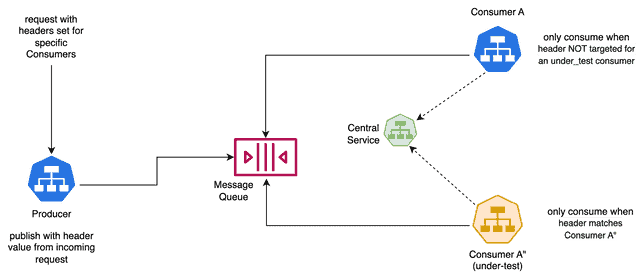
Using OpenTelemetry for Context Propagation
To ensure that tenantIDs are propagated through synchronous requests and asynchronous messages, you can use OpenTelemetry (OTel). OTel is an open source Observability framework that supports context propagation, which allows you to propagate context across service boundaries. OTel provides libraries in various languages that instrument frameworks for context propagation including custom key-value pairs in the form of Baggage. This provides a convenient mechanism to propagate tenantID across synchronous calls and asynchronous messages, including Kafka. OTel also offers auto-instrumentation for dynamic languages such as Java, Node.js, and Python, which you can use to enable context propagation without changing application code.
To instrument Kafka producers and consumers to propagate context through Kafka, you can refer to the concrete example provided in the OTel documentation. This example shows how you could propagate tenantID from publishers through Kafka to the consumers.
Putting it all together
Let’s take an example of services A, B, C, D and Kafka as the baseline. You wish to test an end-to-end flow with new versions of services B” and C”. Assume there is a central service that manages tenants and mappings, and all services are assumed to have OTel instrumentation to propagate tenantIDs. Here’s how you can set up a tenant to test your changes end-to-end:
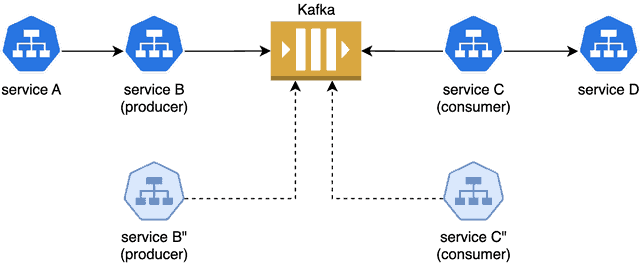
- Build and deploy B” and C” and associate it with a tenant with a unique tenantID=123. The metadata of tenantID and its mapping to B” and C” are stored in the central service.
- C” connects to Kafka as part of a new Consumer Group so it receives a copy of all the messages that C receives.
- Make an HTTP request to A with the tenantID header value set to “123”. This request is routed to B” based on the mapping of tenantID=123 ⇒ (B”, C”). The specific mechanism of this routing depends on the infrastructure on which these services are run. e.g if run in Kubernetes a service mesh or sidecar can be used.
- B” publishes a message to Kafka that includes tenantID=123 in the header.
- Both consumers C and C” receive the message but C drops it whereas C” processes it. Both C and C” base this filtering by getting the mapping from the central service.
- C” makes a synchronous call to D passing in tenantID=123 as a http header.
- Test the entire flow A → B” → Kafka → C” → D end-to-end without having to redeploy Kafka or other services that haven’t changed (e.g A and D).
- Once you’re done with the testing, delete the tenant.
The above example shows an end-to-end testing scenario for one tenant. Such a system can support a large number of concurrent tenants without duplicating infrastructure. Next we look into a few additional considerations when implementing such a multi-tenant system.
Additional Considerations
Here are some additional considerations around the solution detailed above.
Testing Flows that are not Request scoped
The proposed solution may not be sufficient for testing certain types of flows, such as batch jobs that don’t involve external requests. For example, if a batch job reads rows from a database, processes them, and publishes messages to Kafka, the tenantIDs may need to be available in the rows fetched and propagated through Kafka headers.
Distributed Cache Coherency across Kafka Consumers
To optimize performance, it’s recommended to cache the result of the mapping retrieved from the central service locally in all the Kafka consumers. However, this caching introduces the possibility of stale data since the mapping could have been updated in the central service. It’s important to manage the cache properly to ensure cache coherency across Kafka consumers.
Lifecycle of Kafka Consumer Groups
To connect a Kafka consumer with a unique consumer group name, you can choose to either set it up in your application code or via the Kafka CLI. Remember that when you delete the tenant, you should also delete its corresponding consumer group to free up resources in the Kafka broker. It’s important to make sure that the lifecycle of your Kafka consumer groups is synchronized with that of your tenants.
Kafka Consumer Group Offset
You need to consider setting the offset for the Kafka consumers based on your specific use-case. A common scenario is to use the offset of the baseline consumer to process the latest messages.
Conclusion
Scaling environments that use asynchronous systems like Kafka across multiple tenants can present unique challenges. There are several approaches to address them, each with its own advantages and trade-offs in terms of resource isolation and costs. One of the most cost effective methods is to share a common baseline environment across tenants. This approach allows for scalable, isolated testing with minimal operational overhead and eliminates the issue of outdated environments. By utilizing OpenTelemetry to propagate headers through Kafka and by dynamically routing messages, you can achieve efficient scaling of Kafka environments with high levels of isolation and flexibility. It’s worth noting that this approach can be easily extended to other message queues, making it a versatile solution for asynchronous applications.
If you would like to learn more, check out Signadot’s Documentation or continue the discussion on our community Slack channel.